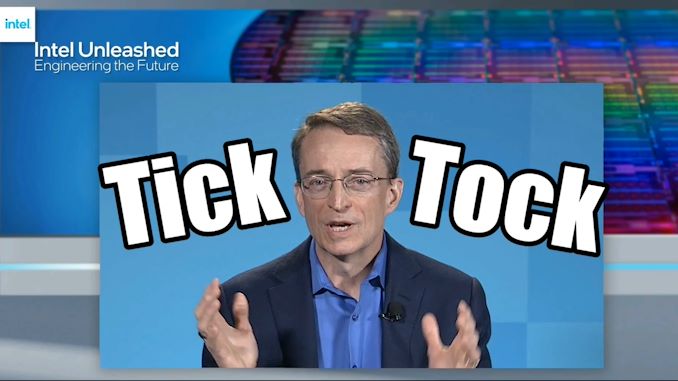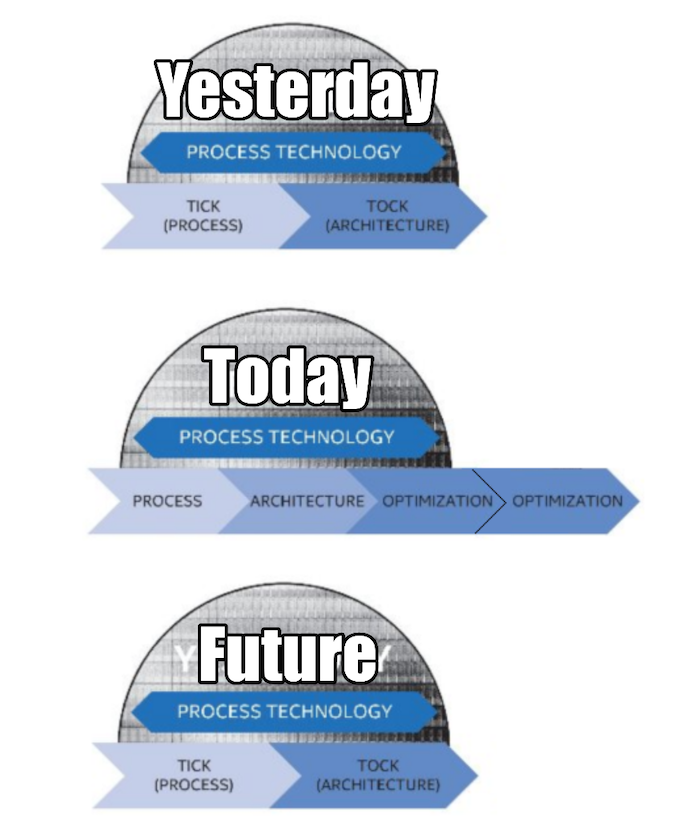Intel to Revive ‘Tick-Tock’ Model, Unquestioned CPU Leadership Performance in 2024/2025
by Dr. Ian Cutress on March 23, 2021 6:31 PM EST- Posted in
- CPUs
- Intel
- Tick-Tock
- 7nm
- Chiplets
- Pat Gelsinger
- Meteor Lake
- Tiles

As part of today’s announcements, during Intel’s Q&A session after the prepared remarks, CEO Pat Gelsinger explained how Intel is going to revive its fortunes when it comes to its leading edge compute products. One of Gelsinger’s mantras seems to be that unquestioned leadership products bring unquestioned leadership margins for those products, and for Intel to execute, it needs to return to its days of old.
In the past, through the 1990s, 2000s, and into the 2010s, Intel’s manufacturing philosophy was known as ‘Tick-Tock’. This means that for every product generation, the leading edge compute hardware was either a Tick (process node enhancement), or a Tock (microarchitecture enhancement). Each generation would alternate between the two, allowing Intel to take advantage of a familiar design on a new process node, or using a mature node to enable a new performance-focused design. That policy was scuppered when delays to Intel’s 10nm forced Intel into more of a Tick-Tock-Optimization-Optimization-Optimization model.
Today CEO Pat Gelsinger stated that at Intel’s core it has to re-establish the Tick-Tock model that enabled repeated leadership in the CPU ecosystem, buoyed by a healthy CPU roadmap. Part of this is re-establishing discipline in Intel’s ranks to continually provide both microarchitecture updates and process node updates on a regular expected cadence. Pat stated as part of the call that Intel will look towards a confirmed yearly process node improvement, and as a result, there might be a lot of Ticks in the future, with a push to more Tocks as well.
On top of this commentary, Pat Gelsinger also stated that Intel’s CPU roadmaps are already baked in through 2021, 2022, and 2023. The company is thus looking to 2024/2025 for ‘unquestioned CPU leadership performance’, which traditionally means the fastest processor for single thread and multi-thread workloads. This is for sure a laudable goal, however Intel will also have to adapt to a changing landscape of chiplet processor designs (coming in 2023), enhancing on-die accelerators (GNA already present), and also what it means to have leadership performance – in the modern era, leadership performance doesn’t mean much if you’re also pushing lots of Watts. Intel stated that its 7nm process is now comfortably on track to deliver Meteor Lake, a client CPU using tiles/chiplets, in 2023, however we are likely looking to a 7nm variant or even external processes for a 2024/2025 product. Intel has also stated that it is looking to consider the core of its leading edge compute on external foundry processes, although one might argue that this doesn’t explicitly say ‘CPU’.
It is also worth noting that Intel/Gelsinger isn’t calling its disaggregated silicon as ‘chiplets’, and prefers to use the term ‘tiles’. This is because Intel’s tiles amount to long wires across 3D packaging technologies like EMIB and Foveros, compared to package-based multi-die interconnect that require buffers as well as control fabric. Tiles by this definition are more costly to implement than chiplets, and have additional thermal considerations by having high-powered silicon close together, so it will be interesting to see how Intel balances these new packaging technologies with the more cost-sensitive elements of its portfolio, such as client processors.
It’s been known that Intel’s microarchitecture teams haven’t been idle waiting for 10nm to come through the pipe, with a number of designs ready and waiting to go for when the process node technology matures. With any luck, if Intel can get a headwind with 7nm, when 2024 rolls around it might all come thick and fast.











109 Comments
View All Comments
Drumsticks - Wednesday, March 24, 2021 - link
I've always found the assumption that AMD's lead will be insurmountable fascinating. AMD was much, much farther behind Intel with the launch of Bulldozer and its subsequent products than Intel is behind AMD now. Have people forgotten the 2500k being comparable in MT to Bulldozer with twice as many cores?Intel's core design is still reasonably good; if Golden Cove has a nice improvement, they'll likely have a higher IPC design than AMD. If Rocket Lake needed twice as many cores as Zen 3 to match it, that'd be one thing, but it's really only at a major disadvantage in one area, efficiency.
The most common response I see to this is that AMD is firing on all cylinders now, but while Intel wasn't making the kind of improvements AMD is making now, they were still turning out good products several years after Bulldozer came out.
Spunjji - Friday, March 26, 2021 - link
Yeah, I entirely agree with you that AMD are in no way "unassailable" at present - especially not by the juggernaut that is Intel. When people will buy your products in huge quantities whether good or bad, you can guarantee the revenue streams required to put good designs together in the current era of CPU design.GeoffreyA - Friday, March 26, 2021 - link
Yes. My belief is that Intel will be back on track one of these years, but it won't be a repeat of the Phenom/Bulldozer era. AMD, having learnt the hard way, is fighting like Goku against Frieza, and I think (I hope?) they'll keep it up. Just watch out for dirty tricks, AMD! Most likely, once Intel's process troubles are mended, we'll see Ryzen and Core toe to toe, each leading slightly at different times. "Core leads, 2030. Ryzen back on top, 2031." Of course, ARM could muddle this nice picture but we'll see what happens.GeoffreyA - Wednesday, March 24, 2021 - link
Agreed. Tick-Tock might not be enough this time. As AMD's Mike Clark, I think, said: "We're going tock, tock, tock."FunBunny2 - Wednesday, March 24, 2021 - link
"We're going tock, tock, tock."one has to wonder when the laws of God make ever smaller nodes impossible. quantum computing is cool, but doesn't fit easily with deterministic tock.
Fulljack - Wednesday, March 24, 2021 - link
I think the point is since AMD are fabless, they'd focus solely on the uArch design and not about the fabrication process.GeoffreyA - Wednesday, March 24, 2021 - link
"ever smaller nodes impossible"I think we're on the verge of that now, quantum tunnelling effects kicking in at <= 3 nm. I'd like to see what TSMC, Intel, AMD, and Apple do once the limit is reached. As for quantum computing, I sometimes wonder if these computers are really doing anything more than just being indeterministic---even a classical computer can simulate a QC, I believe, but orders of magnitude slower. At any rate, I need to get a better grounding on this topic.
GeoffreyA - Wednesday, March 24, 2021 - link
* just being probabilisticzodiacfml - Tuesday, March 23, 2021 - link
wow 2024. we're not even half of 2021. if they could just take the hit and be the value option.Drumsticks - Wednesday, March 24, 2021 - link
AMD embraced being the "value option" once long ago, I think it was like 2013? They didn't get on top with Zen (really Zen 2 and 3) by embracing the value option though. AMD ultimately didn't settle for mediocrity, and we shouldn't really want Intel to either. AMD is probably driven right now by the knowledge that Intel *can* put out capable products and execute a capable roadmap - the fact that they haven't for the last few years might inform expectations, but neither AMD nor us should assume Intel will never get a competent roadmap executed again.